 | | | Switch to: Europe, USA, New Zealand, Antarctica Credit: NOAA/Ovation  Planetary K-index Planetary K-index
Now: Kp= 1.00 quiet
24-hr max: Kp= 3.33 quiet
explanation | more data
Interplanetary Mag. Field
Btotal: 5.38 nT
Bz: -1.09 nT south
more data: ACE, DSCOVR
Updated: Today at 1147 UT  Coronal Holes: 01 Jul 25 Coronal Holes: 01 Jul 25 
Solar wind flowing from this southern coronal hole could reach Earth on July 4-5. Credit: NASA/SDO | more data  Polar Stratospheric Clouds
Colorful Type II polar stratospheric clouds (PSC) form when the temperature in the stratosphere drops to a staggeringly low -85C. NASA's MERRA-2 climate model predicts when the air up there is cold enough: 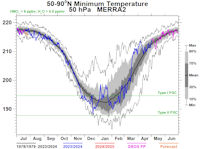
On Jun 30, 2025, the Arctic stratosphere is much too hot for polar stratospheric clouds. | more data. Noctilucent Clouds
The northern season for noctilucent clouds is underway. First reports of the electric-blue clouds came from Russia on May 28, 2025. Since then, the clouds have spread to lower latitudes, reaching Paris, France, during a major outbreak on June 23, 2025.
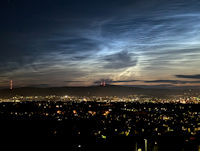
Above: June 30, 2025, in N. Ireland
"A beautiful NLC display over Belfast! It latest about an hour before beginning to fade," says photographer Ross McLaughlin of Belfast, Northern Ireland.
See the complete NLC Photo Gallery
 SPACE WEATHER
NOAA Forecasts | | Updated at: 2025 Jul 01 2200 UTC FLARE | 0-24 hr | 24-48 hr | CLASS M | 20 % | 15 % | CLASS X | 05 % | 01 % |  Geomagnetic Storms: Geomagnetic Storms:
Probabilities for significant disturbances in Earth's magnetic field are given for three activity levels: active, minor storm, severe storm Updated at: 2025 Jul 01 2200 UTC Mid-latitudes | 0-24 hr | 24-48 hr | ACTIVE | 35 % | 40 % | MINOR | 30 % | 25 % | SEVERE | 15 % | 05 % | High latitudes | 0-24 hr | 24-48 hr | ACTIVE | 05 % | 10 % | MINOR | 20 % | 20 % | SEVERE | 70 % | 65 % | | | |  | | | | | | | | | | | This is an AI Free Zone: AI isn't all bad. Large language models are good writers with access to vast stores of data. There's still no substitute for a human being with decades of space weather forecasting experience. This website is 100% human. | | | A CME IS COMING: But it's not a big one. A minor CME is expected to strike Earth during the late hours of July 1st, according to a NASA model. The impact could spark G1-class geomagnetic storms with high-latitude auroras on July 2nd. CME impact alerts: SMS Text A MAJOR OUTBREAK OF NOCTILUCENT CLOUDS: The night sky over Canada and Europe turned electric blue on June 29-30 during a major outbreak of noctilucent clouds (NLCs). "I captured two panoramas of the great display," says Alan Dyer of Gleichen, Alberta. Here is a fraction of what he observed: 
Click here and here for the full-sized panoramas. They show the clouds' broad sweep and multiple colors, including rare reds described below. NLCs are Earth's highest clouds (altitude 83 km). They appear every June when summertime wisps of water vapor rise to the edge of space and form rimes of ice around the ash of burned-up meteors.Fine ripples and a blue glow distinguish them from ordinary clouds. Blue wasn't the only color Dyer saw. Red was there, too: 
What makes NLCs red? First, let's understand what makes them blue. Spoiler alert: It's ozone. Research in the 1970s established that sunlight hitting noctilucent clouds first travels through Earth's ozone layer. Ozone absorbs red light, while allowing blue to pass--hence the usual color of the clouds. On rare occasions, however, strong refraction bends red light from the sunset upward from the lower atmosphere. This light is so intense, not even ozone can stop it from painting the tops of the clouds red. This was the biggest outbreak of the year with bright ripples visible as far south as Paris, France. Anyone living at mid-latitudes or above should be alert for NLCs. The best time to look is after sunset when geometry favors their visibility. Realtime Noctilucent Cloud Photo Gallery
Free: Spaceweather.com Newsletter CONSTELLATION CAT NIGHT LIGHT: It's the most far-out feline night light ever--the Constellation Cat Crystal Ball. On April 23, 2025, the students of Earth to Sky Calculus launched it to the stratosphere onboard a giant helium balloon.
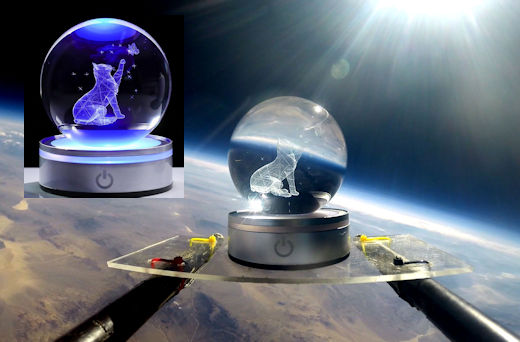
You can have it for $139.95. Outlined by stars in the style of an astronomical constellation, the laser-etched cat comes with an LED stand that produces a soothing glow for your bedside table. Also included: A unique greeting card shows the crystal ball in flight and tells the story of its journey to the edge of space. Far Out Gifts: Earth to Sky Store
All sales support hands-on STEM education
Realtime Aurora Photo Gallery
Free: Spaceweather.com Newsletter
Realtime Space Weather Photo Gallery
Free: Spaceweather.com Newsletter Every night, a network of NASA all-sky cameras scans the skies above the United States for meteoritic fireballs. Automated software maintained by NASA's Meteoroid Environment Office calculates their orbits, velocity, penetration depth in Earth's atmosphere and many other characteristics. Daily results are presented here on Spaceweather.com. On Jul 01, 2025, the network reported 13 fireballs.
(12 sporadics, 1 Northern June Aquilid) 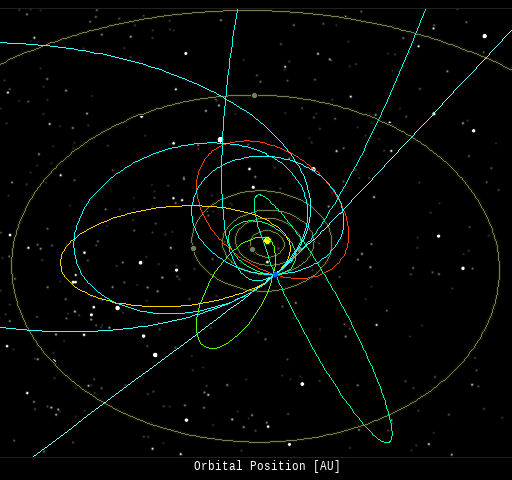 In this diagram of the inner solar system, all of the fireball orbits intersect at a single point--Earth. The orbits are color-coded by velocity, from slow (red) to fast (blue). [Larger image] [movies] Potentially Hazardous Asteroids ( PHAs) are space rocks larger than approximately 100m that can come closer to Earth than 0.05 AU. None of the known PHAs is on a collision course with our planet, although astronomers are finding new ones all the time. On July 1, 2025 there were 2349 potentially hazardous asteroids.
 | Recent & Upcoming Earth-asteroid encounters: | Asteroid | Date(UT) | Miss Distance | Velocity (km/s) | Diameter (m) | | 2025 MK2 | 2025-Jun-26 | 7.1 LD | 4.7 | 13 | | 2025 MR89 | 2025-Jun-26 | 5.5 LD | 8.6 | 20 | | 2025 MT1 | 2025-Jun-27 | 15.5 LD | 2.4 | 20 | | 2014 DH | 2025-Jun-28 | 17.1 LD | 12.1 | 17 | | 2025 MZ1 | 2025-Jun-28 | 3.4 LD | 4.6 | 15 | | 2025 MS88 | 2025-Jun-28 | 4.4 LD | 10.1 | 22 | | 2025 ML | 2025-Jun-28 | 6.7 LD | 11.7 | 26 | | 2025 MV88 | 2025-Jun-29 | 9.2 LD | 21.7 | 34 | | 2025 MW89 | 2025-Jun-30 | 5.5 LD | 4 | 13 | | 2025 MM | 2025-Jul-01 | 5.4 LD | 10.7 | 40 | | 2025 MK90 | 2025-Jul-02 | 13.8 LD | 9.4 | 30 | | 2025 MY88 | 2025-Jul-04 | 8.8 LD | 8.5 | 36 | | 2025 MV89 | 2025-Jul-04 | 5.1 LD | 8.7 | 39 | | 2025 MN88 | 2025-Jul-06 | 1.9 LD | 7.8 | 20 | | 2025 MO | 2025-Jul-07 | 6.7 LD | 4.6 | 10 | | 2019 JM | 2025-Jul-09 | 16.6 LD | 6.9 | 14 | | 2019 NW5 | 2025-Jul-09 | 15.2 LD | 16.5 | 65 | | 2025 MH90 | 2025-Jul-10 | 19.4 LD | 6.5 | 53 | | 2025 MD89 | 2025-Jul-11 | 14.7 LD | 8 | 38 | | 2005 VO5 | 2025-Jul-11 | 15.9 LD | 14.4 | 382 | | 2025 MD1 | 2025-Jul-11 | 18 LD | 8.9 | 44 | | 2025 MG1 | 2025-Jul-12 | 13.2 LD | 7.2 | 41 | | 2025 MA90 | 2025-Jul-15 | 17 LD | 9.1 | 89 | | 2022 YS5 | 2025-Jul-17 | 17.4 LD | 6.1 | 38 | | 2018 BY6 | 2025-Jul-19 | 13.7 LD | 7.4 | 69 | | 2019 CO1 | 2025-Aug-08 | 17.8 LD | 10.5 | 65 | | 2022 QB1 | 2025-Aug-10 | 8.9 LD | 3.9 | 6 | | 2021 PJ1 | 2025-Aug-15 | 4.4 LD | 9.3 | 24 | | 2025 CO3 | 2025-Aug-16 | 19.8 LD | 8.4 | 90 | | 1997 QK1 | 2025-Aug-20 | 7.9 LD | 9.8 | 322 | | 2022 QD3 | 2025-Aug-21 | 15 LD | 6.9 | 35 | | 2023 PX | 2025-Aug-22 | 2.4 LD | 8.3 | 23 | | 2019 QQ6 | 2025-Aug-24 | 9.4 LD | 17.2 | 31 | | 2017 RK15 | 2025-Aug-29 | 15.8 LD | 13.2 | 26 | | 2020 TS1 | 2025-Aug-29 | 17.8 LD | 3.3 | 5 | Notes: LD means "Lunar Distance." 1 LD = 384,401 km, the distance between Earth and the Moon. 1 LD also equals 0.00256 AU. | | Cosmic Rays in the Atmosphere | SPACE WEATHER BALLOON DATA: Almost once a week, Spaceweather.com and the students of Earth to Sky Calculus fly space weather balloons to the stratosphere over California. These balloons are equipped with sensors that detect secondary cosmic rays, a form of radiation from space that can penetrate all the way down to Earth's surface. Our monitoring program has been underway without interruption for 10 years, resulting in a unique dataset of in situ atmospheric measurements. Latest results (Nov. 2024): Atmospheric radiation is sharply decreasing in 2024. Our latest measurements in November registered a 10-year low: 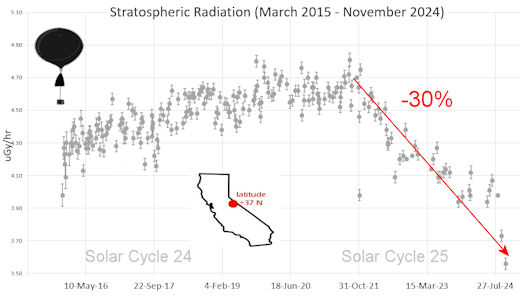
What's going on? Ironically, the radiation drop is caused by increasing solar activity. Solar Cycle 25 has roared to life faster than forecasters expected. The sun's strengthening and increasingly tangled magnetic field repels cosmic rays from deep space. In addition, solar coronal mass ejections (CMEs) sweep aside cosmic rays, causing sharp reductions called "Forbush Decreases." The two effects blend together to bring daily radiation levels down. .Who cares? Cosmic rays are a surprisingly "down to Earth" form of space weather. They can alter the chemistry of the atmosphere, trigger lightning, and penetrate commercial airplanes. According to a study from the Harvard T.H. Chan school of public health, crews of aircraft have higher rates of cancer than the general population. The researchers listed cosmic rays, irregular sleep habits, and chemical contaminants as leading risk factors. A number of controversial studies (#1, #2, #3, #4) go even further, linking cosmic rays with cardiac arrhythmias and sudden cardiac death. Technical notes: The radiation sensors onboard our helium balloons detect X-rays and gamma-rays in the energy range 10 keV to 20 MeV. These energies span the range of medical X-ray machines and airport security scanners. Data points in the graph labeled "Stratospheric Radiation" correspond to the peak of the Regener-Pfotzer maximum, which lies about 67,000 feet above central California. When cosmic rays crash into Earth's atmosphere, they produce a spray of secondary particles that is most intense at the entrance to the stratosphere. Physicists Eric Regener and Georg Pfotzer discovered the maximum using balloons in the 1930s and it is what we are measuring today. | | The official U.S. government space weather bureau | | | The first place to look for information about sundogs, pillars, rainbows and related phenomena. | | | Researchers call it a "Hubble for the sun." SDO is the most advanced solar observatory ever. | | | 3D views of the sun from NASA's Solar and Terrestrial Relations Observatory | | | Realtime and archival images of the Sun from SOHO. | | | information about sunspots based on the latest NOAA/USAF Active Region Summary | | | current counts of failed and deployed Starlink satellites from Jonathan's Space Page. See also, all satellite statistics. | | | Authoritative predictions of space junk and satellite re-entries | | | from the NOAA Space Environment Center | | | fun to read, but should be taken with a grain of salt! Forecasts looking ahead more than a few days are often wrong. | | | from the NOAA Space Environment Center | | | the underlying science of space weather |  | Got a chipped or cracked windshield that prevents you from seeing space weather events while driving? Get windshield replacement from SR Windows & Glass with free mobile auto glass service anywhere in the Phoenix area. |  | BestCSGOGambling is the best site for everything related to CSGO gambling on the web | | | These links help Spaceweather.com stay online. Thank you to our supporters! | | | | | | | | |  | |  |   | ©2021 Spaceweather.com. All rights reserved. This site is penned daily by Dr. Tony Phillips. | |

